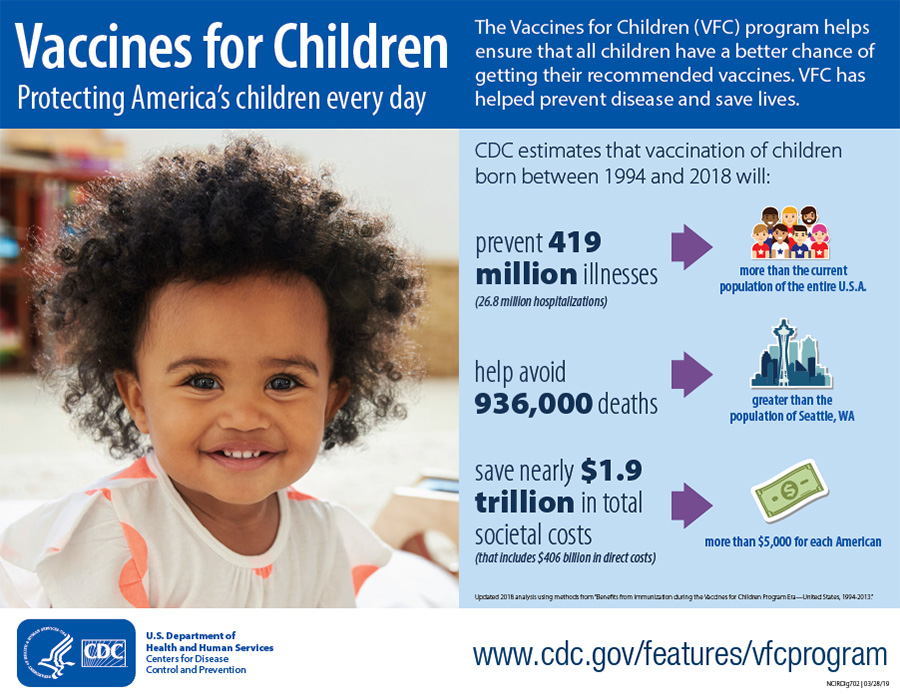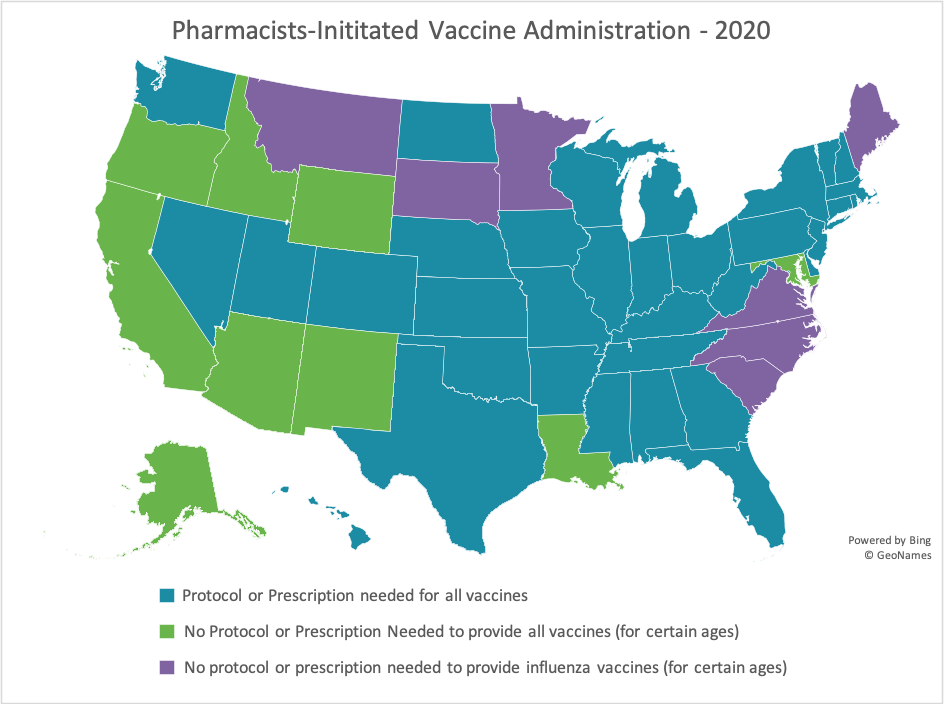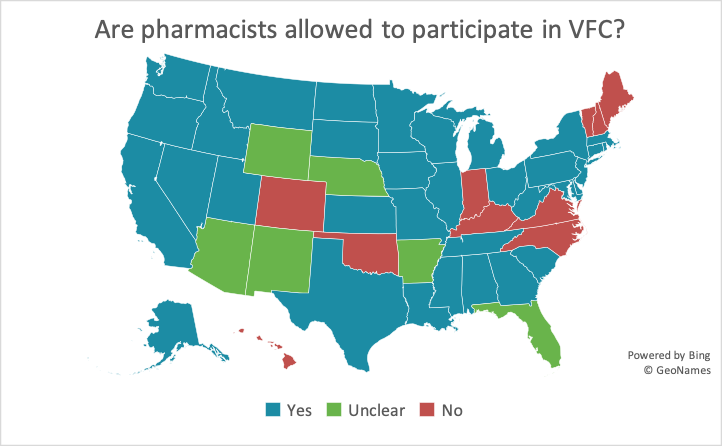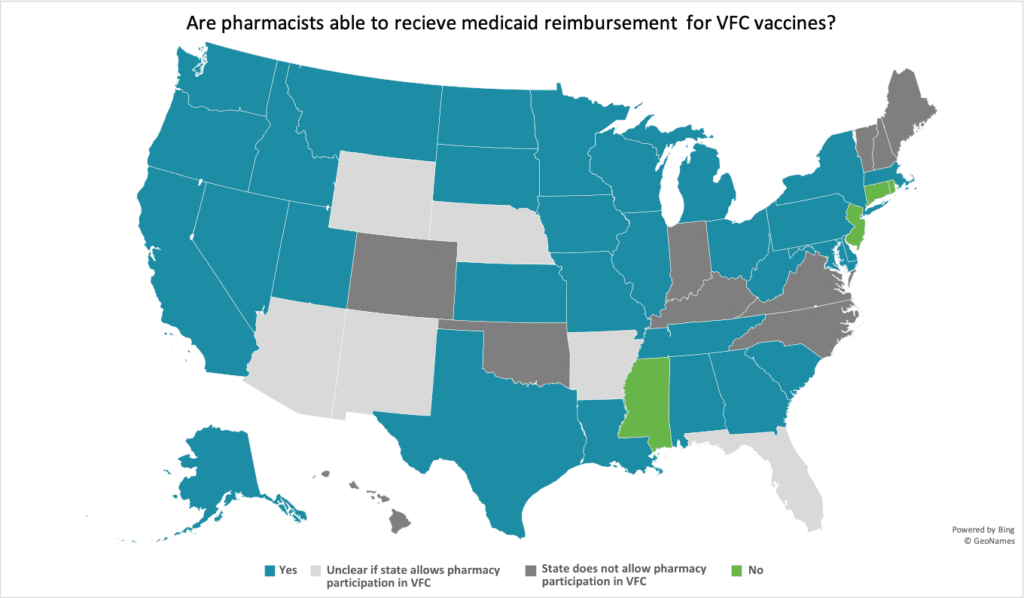By Kayla Knock and Ellie Dullea
Pharmacies serve as an important community-based access point for vaccinations and have the potential to better serve children by participating in the federal Vaccines for Children (VFC) program. The VFC program is a federally funded program that provides vaccines at no cost to children who might not otherwise be vaccinated because of inability to pay. While all 52 states and territories allow pharmacists to vaccinate adults, not all states allow pharmacies to participate in the VFC program. Further, additional barriers such as differing state laws and regulations, retail pharmacy policies and pharmacists’ scope of practice can limit a state’s ability to deliver vaccinations to VFC-eligible children through pharmacies.

To better understand common successes and challenges experienced across the United States regarding pharmacists’ participation in the VFC program and delivery of VFC vaccines, Immunize Colorado staff researched pharmacists’ role in VFC and developed recommendations for improving participation in this important program. Given additional barriers to seeking care due to the COVID-19 pandemic, improving accessibility to vaccination for all through pharmacies can be an important step towards preventing additional infectious disease outbreaks, ensuring vaccine equity and establishing collaborations between primary care providers who serve children on Medicaid but do not provide vaccines and pharmacists.
We began our research by examining each state and territory’s Vaccines for Children program and immunization regulations pertaining to pharmacists. Looking state by state, we attempted to answer three primary questions:
- Does the state participate in the federal VFC program?
- Does the state allow pharmacists to participate in their VFC program?
- What rules and regulations determine a pharmacist’s power to vaccinate in each state?
By analyzing each state’s pharmacy and VFC rules and regulations, we learned that the ability to vaccinate children in a pharmacy setting varies significantly across states.
What is the role of pharmacists in providing vaccines in the United States?

Many states restrict the ability of their pharmacists to independently prescribe and deliver childhood immunizations. For example, 36 states require a physician protocol or prescription for all vaccinations, seven states require a protocol or prescription for all vaccinations except for influenza, and only nine states grant their pharmacists prescribing powers for all ACIP recommended vaccines for certain ages. Additionally, 22 states restrict the vaccinating powers of their pharmacists further through age restrictions on the populations that pharmacists are permitted to vaccinate, with and without a protocol and prescription.

While all 52 states and territories participate in the VFC program, only 34 states definitively allow pharmacists participate in the VFC program. In 18 states, VFC-eligible children are excluded from accessing required pediatric vaccinations in a convenient setting such as a pharmacy. Some experts support expanding participation of pharmacies in VFC as a method to reduce childhood immunization disparities and expand equitable access to vaccines. Others express concern that expanding the VFC program to pharmacists would discourage medically-underserved children from receiving comprehensive primary care services in a pediatric medical home—a critical strategy to ensure these children receive developmental screenings, anticipatory guidance on growth and behavioral health milestones and concerns and other services available in a medical home.
What factors promote successful pharmacist participation in VFC?
Universal Purchase of Vaccines by States
Ten states currently practice Universal Purchasing (UP) and have policies in which each state purchases all recommended vaccines from the CDC federal contract and supplies them to providers to administer to all children regardless of insurance status. Those states include Alaska, Idaho, Maine, Massachusetts, New Hampshire, New Mexico, Oregon, Rhode Island, Vermont and Washington. The number of recommended vaccines has increased, along with the cost; routine immunizations in the United States are currently $1,781 for VFC, and $2,559 for private insurance per child for all CDC recommended vaccines as of July 2020. States that have adopted UP and the bulk purchasing of vaccines can reduce the burden on providers who must finance up-front vaccine costs by streamlining reimbursement through one system. UP policies also reduce the cost of administering the vaccines through state-negotiated pricing. Through UP bulk purchasing programs, providers benefit from a streamlined vaccine delivery chain and from having financially risk-free vaccines, which enhances a provider’s ability to offer more vaccinations to vulnerable populations who utilize the VFC program. UP also removes administrative and inventory management challenges for providers to order and manage various stocks of vaccine. In an analysis, Immunize Colorado staff found that eight of the ten states that practice UP also allow pharmacists to participate in the VFC-program, allowing more delivery methods for vaccines.
Lowered Age Restrictions
While all states allow pharmacists to vaccinate, age restrictions limit the type of vaccines pharmacists can administer, which age groups of patients can be vaccinated, and which prescription or protocol pharmacists must follow. Immunize Colorado staff examined the immunization laws in every state and found 30 allow pharmacists to administer vaccinations at any age, resulting in pharmacists reaching more children. In Alaska, pharmacists can both prescribe and administer all CDC recommended vaccinations without a protocol or prescription from a physician to any age group, contributing to higher overall vaccination rates across the entire state. Ultimately, pharmacists can expand immunization coverage by increasing access to both youth and adults, but by also recommending vaccines to patients in line with the National Vaccine Advisory Committee.
What factors prevent successful pharmacist participation in VFC?
Financial Barriers
While there are no costs to participate in the VFC program, pharmacists and other providers carry associated costs to store and administer vaccine. These expenses can add up when considering the purchase of medical-grade refrigerator, temperature logging equipment, inventory management and the costs of vaccine administration. In 30 states including Nevada, Louisiana, and Minnesota, VFC pharmacists can bill Medicaid for a small administrative fee to help offset these overhead costs. Unfortunately, state Medicaid offices only provide reimbursement for Medicaid-eligible patients. For other VFC-eligible patients including uninsured, underinsured, Native American, and Alaskan Native children, pharmacists can request that patients pay a small administrative fee but cannot deny treatment if the patient is unable to pay. Many pharmacists are unwilling to take on this additional financial risk by participating in the program.

Many VFC providers also report that Medicaid reimbursement is inadequate to cover the cost of administering VFC vaccines. Many pharmacies in Indiana have been forced to close down due to low Medicaid reimbursement rates for prescription drugs and vaccines. The level of Medicaid reimbursement can vary widely by state; Alabama pharmacists are reimbursed $8.00 while Oregon pharmacists are reimbursed $21.86 per VFC vaccination. For every VFC vaccination, practices lose approximately $5.00-15.00. Participating in VFC is often not financially feasible for pharmacies with current levels of Medicaid reimbursement.
States with Medicaid Managed Care may also present additional barriers for pharmacists to receive vaccine administration fee reimbursements. In most cases, children who are enrolled in these types of plans are required to receive care from designated providers; otherwise, the service may not be reimbursed. This is commonly called a “lock-in” requirement. There are some exceptions to this. Some States have written conditions into their contracts with managed care organizations (MCO’s) requiring the plan or the State to pay immunization administration fees to non-plan providers.
Administrative Barriers
In many states, enrolling in VFC is a time-consuming administrative process which can be a barrier for enrollment in the program. A 2017 study showed only one in ten Michigan pharmacies were able to enroll in the state’s VFC program due to the time and resource constraints of Michigan’s Department of Health.
Because VFC vaccines are taxpayer funded and must be managed and administered with strong oversight, once enrolled, VFC providers are required to comply with strict accountability mandates. For example, to comply with VFC requirements, a provider must keep detailed temperature logs, participate in site visits by state officials, and buy expensive medical-grade equipment to store VFC vaccines. In Kansas, 30% of VFC providers reported that the administrative burden of participating in VFC prevented them from continuing to participate in the program after one year. Many pharmacists, along with other primary care providers, are discouraged from enrolling or continuing participation in VFC due to the additional work and cost burdens.
Low Societal Demand
Many VFC pharmacists struggle with low demand from eligible patients. Families are often encouraged to receive vaccinations in a medical home as opposed to a pharmacy in order to ensure complete medical care is received. Additionally, many families are simply unaware that pharmacies in their local community can provide VFC vaccines. A Kansas VFC provider was forced to drop out of the immunization program because there was not enough demand from VFC-eligible children in their area to make staying in the program viable. In order for a VFC pharmacy program to be successful, there must be a high demand for vaccinations by eligible patients.
How can we increase pharmacists’ participation in VFC?
There are specific steps that state VFC programs, legislatures, immunization coalitions and pharmacists can take to increase pharmacists’ participation in VFC:
- Establish open communication and collaboration between state Medicaid and state immunization programs. Increased collaboration between these state offices will allow more information sharing and hopefully a more efficient VFC program that will benefit all VFC providers, not just VFC pharmacies.
- State VFC programs should streamline the enrollment process for new VFC providers. In order to increase pharmacy participation, each state should develop clear guidelines and support systems for pharmacies as they enroll in the VFC program.
- Increase collaboration between VFC programs and Medicaid offices to reduce financial barriers for pharmacists’ participation in the VFC program. These offices must ensure that it is financially viable for pharmacists to participate in VFC by developing systems to adequately reimburse pharmacists for their vaccination services.
- Increase collaboration between pharmacists, immunization coalitions and medical providers in promoting pharmacies as a convenient and beneficial venue for pediatric vaccination. Patient education within the community and pharmacy setting will increase the demand for pharmacy delivered VFC vaccines.
We Must Respond Now
The importance of pharmacists as VFC providers has only increased during the COVID-19 pandemic. Over the last six months, COVID-19 has prevented many children from receiving routine vaccinations on schedule due to closing doctor’s offices and public health clinics. Routine childhood immunization rates have decreased leaving our communities at greater risk of vaccine-preventable disease outbreaks. Pharmacies can help combat decreasing vaccine coverage by supporting primary care providers and offering VFC vaccines in a convenient community location. Flu season is around the corner and pharmacists have always been an important delivery site for flu vaccine. In order to encourage high flu vaccination rates, some states are allowing pharmacists to provide VFC flu vaccine, even if they are not officially participating in the full VFC program. Other strategies like this are critical to increasing immunization rates and reducing the burden of vaccine-preventable diseases, especially during a global pandemic.
Share this summary fact sheet of findings from Immunize Colorado’s analysis with your state immunization coalitions, legislators, Medicaid offices and local pharmacies.
If you would like more information, please contact icoffice@childrenscolorado.org
Kayla Knock MPH, is Immunize Colorado’s Program Manager.
Ellie Dullea is Immunize Colorado’s Immunization and Outreach & Education Coordinator, on assignment with the organization through the CO-immunity Corps AmeriCorps VISTA program.
